Joe Ray
Food & Travel / Words & Photos
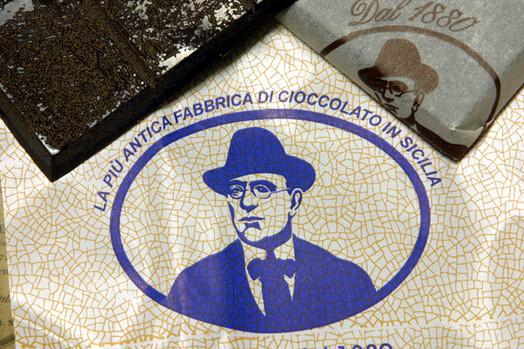
Saturday, March 10, 2007
Seeking Chocolate Harmony
Many of you who wanted to know why I would suck lemons with the pros, but not taste chocolate with them. You’ll be happy to know that I have bowed to reader pressure. I’ve now sat in on two straight weeks of tasting Modican chocolate.
It’s unique stuff. Most notably, it tends to be quite granular due to a low cooking temperature that leaves the sugar in crystal form until you’ve had it in your mouth. When it lets go, seemingly all at once, it does it in a flood of sweet goodness.
The typical flavors for the chocolate can range from near straight-up cacao to something with a fiery pepper flavor, but it can also have toasty or even herbal notes; defining what these flavors are and whether or not they are a good thing is the testers’ job.
A couple things struck me right off the bat:
It’s hard work. After five years in France, I’ve never been to a wine tasting so meticulous and scientific in its pursuit to define what’s in your mouth as what the chocolate tasters pursue. Sometimes, you ask someone a question before looking at them, only to realize their eyes are rolled up in the back of their head in some strange form of gustatory concentration.
Things get rolling with a visual test, where Dr. Giuseppe Cicero has complete bars of the chocolate on display at the front of the classroom. Each chocolate is judged on characteristics like opacity, brilliance, color, mottled-ness, and so on.
It’s a relatively easy place to start and ‘relative’ turns out to be a key word. All of the chocolates (they tend to judge about six per week) are lying there and figuring out the difference between chestnut brown, deep brown and black is easier when they are next to one another.
Smelling and tasting, however, can be baffling. It’s also quite fun once you start getting the hang of it. In the beginning, mixed in with all of the other smells in the Dixie cup, who’s to say if something smells more of vanilla or cinnamon? Somewhere during the second tasting, though, I noticed my scores for each of those two tastes become more independent of one another. Other weird correlations crop up: spiciness and overall intensity were often linked, and high intensities of a flavor aren’t necessarily a bad thing.
It’s how it all goes together, in an effort to make perfect chocolate harmony.
And I’m going to keep doing this until I get it right.
This is Joe Ray reporting from the Motherland.
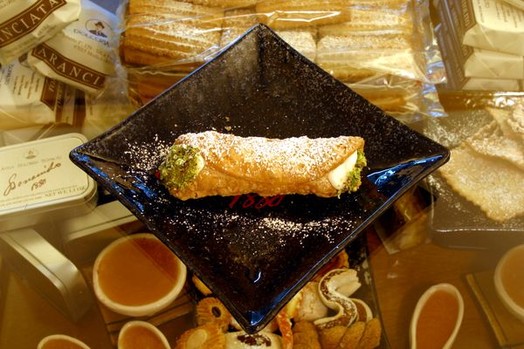
Sunday, February 25, 2007
Leave the gun.
Somewhere along the line, Sicily’s signature dessert must have won an award for the unhealthiest dessert imaginable. Looking conspicuously like a clogged artery, the best cannoli here combine large amounts of cheese, sugar, eggs and … pork fat.
Crunch into a good one, however, and the flavors and textures of the crisp shell surrounding the filling of subtly sweetened fresh ricotta cheese and all those bad thoughts disappear quickly.
It’s heaven in a tube.
Walk into Modica’s Antica Dolceria Bonajuto, one of Italy’s best-known chocolatiers, and the smell is heady.
You also need to be lucky enough to know that this is where some of Sicily’s best cannoli are created. Despite the chocolate and pastries in a glass box at the counter, cannoli are not on display, and that’s one of the secrets that Pierpaolo Ruta, the latest in a long, crooked family line of chocolatiers that spans back to 1880, claims isn’t a secret.
“We really don’t have any secrets,” he said. Then he listed some. Who knows? Perhaps he considered them tricks.
Pierpaolo explains a couple like using red wine in the tube dough to give it more color and pushing the fresh ricotta through a sieve to give the filling an extra-creamy texture.
Ruta then sets a plate of snow-white pork fat under my nose.
“This is the smell of my grandfather,” he says.
I raise my eyebrow, quietly praying for some sort of cross-cultural miscommunication.
“When I think of my grandfather, I think of two smells: chocolate and cannoli.”
He boils the cannoli smell down to the scent of the vanilla they put in the filling and the frying oil for the shell. Plus, here in the land where butter is a bit of an oddity, some places will fold small amounts of it into the crust dough.
Ruta calls into the kitchen behind the shop and asks for a cannoli, giving me the feeling I’m getting something that’s not on the menu at a restaurant.
Here, and at any self-respecting cannoli maker, they’re made to order. This ensures that the moisture doesn’t migrate from the filling (where you want it) to the shell (where you don’t). Some places get around the problem by coating the inside of the tube with chocolate and busy places can rely on fast turnover to keep things relatively crunchy. For orders that aren’t for immediate consumption, Bonajuto customers are sent away with a box of shells and a bag of filling.
As for the house preference for frying oil, knock it only after trying it. You may find yourself making more space for pork products on your dessert plate.
This is Joe Ray reporting from the Motherland.
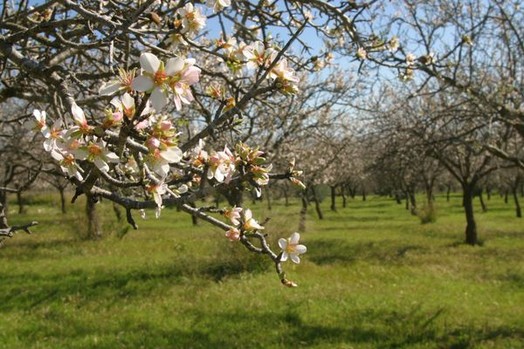
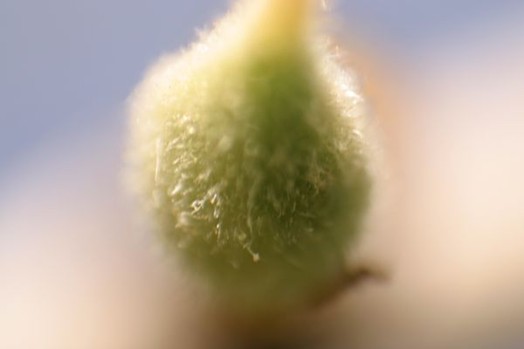
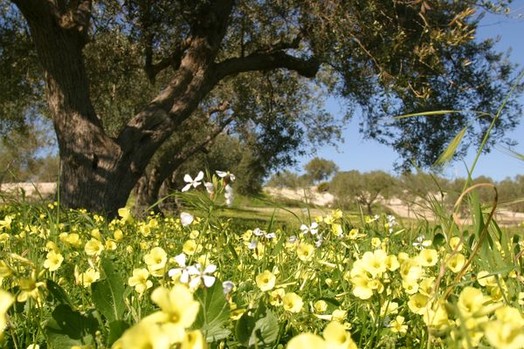
Wednesday, February 21, 2007
How The Rototiller Makes Life Taste Better
The other day, Francesco and I grabbed some sandwiches in town and headed out to the farm where his family grows the majority of their almond trees. It was one of those window-down, drive through the countryside days that made me shout the obvious, “Damn! It’s nice out!”
You’d never know it’s February here. The almond flowers are in full bloom, with some of the petals already on the ground. Wildflowers are everywhere, particularly between the rows of trees.
“It’s wilder here in Syracuse,” he explained in the car on the way here.
“That’s the difference between the Syracuse and Ragusa provinces,” explained Francesco. Ispica, where he lives, is a ten-minute drive away in Ragusa.
“See? Here there are no stone walls,” he said as we crossed the border. Sure enough, the beautiful stone walls that line almost every road in Ragusa disappeared.
Not only that, all the hedges of wild fennel, flowers and brush which are part of a bigger group of plants known as macchia mediterranea were overgrown, spilling out into the road.
You get the feeling that the Ragusans think the Syracusans are a bunch of slobs.
It’s just a different kind of beauty.
Francesco needed to head out there to check on the planting of some year to two-year old olive tree saplings and I stop by one of the holes they’ve dug for the trees. The very dense clay-like soil ranges in color from near-white to brown.
It’s so dense, I start wondering about tilling the soil, but then it dawns on me: tilling can’t do much for trees and vines other than encourage them to send their roots downward.
Au contraire, I learned – rototilling feeds them lunch.
One of the things I’m beginning to appreciate about the Sicilian countryside is that the more you slow down, the more diversity you notice. When I hit the halfway point on my run through the canyon that links Ispica and Modica, I stop, turn off the headphones and listen for five minutes. Between the birds and the bugs, I bet I hear 20 different species.
Under any given almond and olive tree in Francesco’s father’s fields, a similar diversity exists on the ground – along with the grass, there are a good 20 different kinds of plants and wildflowers, from prickly nettles to blue and white flowers, most of which are part of macchia mediterranea. The star of the show, however, is a yellow flower Francesco’s mother calls sinacciuolu. (I’m working on the English/botanical name. Bear with me.)
Here, sinacciuolu encircles the bases of the olive trees, with those in the sun of the tree open, while those in the tree’s shade are closed.
“Take a bite,” suggested Francesco, who chomped off the lower half of one of the stalks.
“You taste it and it’s sweet and bitter and you’re not sure if you like it, when you finish, you want more,” I offered.
“Sounds like a good way to describe Sicily,” he replies.
The aside makes me grin, but it also brings us back to tilling.
The tilling usually happens between spring and summer seasons, though today, they’re tilling lightly around the new trees to help the soil catch the rain.
“Regular” tilling not only loosens up the top foot or so of soil and buries the long grass that could dry out and start fires but it also provides lunch for the neighboring trees.
“You mix the grass and flowers and prepare a sort of meal for the trees,” says Francesco.
I snicker.
“To me,” he continues, “I can taste the macchia mediterranea from the first smell right through to the aftertaste. It’s like someone is taking a bunch of the flowers, and they fly into your senses.”
It’s important to note here that Francesco used to work for a big advertising agency in Milan.
Later, though, I grab a bottle of the oil and put it to the macchia mediterranea test. Alone, I slurp a good teaspoon’s worth from the bottle and make the cat-retching noise that vaporizes a bit of the viscous oil, making it easier to taste.
It’s wonderful oil, but in terms of the wildflowers, I taste nothing. I smirk and set the bottle down ready to go make some dinner. Then I stop smirking. Sure enough, there it is in my mouth: sinacciuolu.
“A meal for the trees” it is, then.
This is Joe Ray reporting from the Motherland.
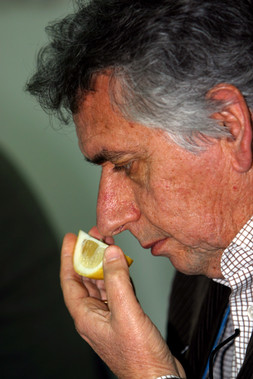
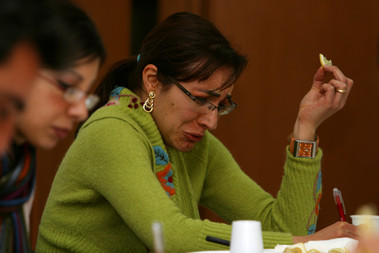
Friday, February 16, 2007
Sucking Lemons with the Pros
Here in southern Sicily, lemon and orange groves seem to line every road, but the idea of a lemon tasting I was invited to sounded rather masochistic. It made me think of a puckered-up version of that old National Geographic picture with the line of women in lab coats sniffing men’s underarms.
Plus, a lemon’s a lemon, right?
Not so, thinks Dr. Giuseppe Cicero who works for Italy as a sensorial analyst and food-quality controller.
Cicero’s lemon tasting directly followed a tasting of renowned Modican chocolate and the two couldn’t have elicited more different reactions. He wheeled several hospital carts’ worth of lemons on numbered plastic plates out to his tasters. These local food professionals taste with Cicero weekly. They clearly enjoyed the chocolate, but their bodies were definitely at odds with the idea of straight lemon.
Far from the physical restraint normally seen at wine tastings, here the tasters recoiled, puckered, shuddered, occasionally giggled, and generally tended to look like they were having way less fun than they did with the chocolate.
Clearly, they were pushing themselves toward their task for the good of humanity. But what good?
“We’re looking for both common characteristics and what differentiates them,” said Cicero. “Tomatoes and carrots come from the earth and they speak of the earth. They have a primal link to their territory. We want to transfer these sensations to the people who eat them.”
In wine terms, he sounded like a sommelier who was trying to make a bottle sound better than it was, so I asked for my own plates of lemons.
Like his tasters, I had trouble pulling a plate full of lemons toward me, but then a funny thing happened.
On a good day, when I poke my nose in a glass of wine, I can pick out a few key elements; something really good will actually give me goose bumps or a flicker of emotion.
Here, the smell of lemons, of all things, triggered memories and feelings, and each type of lemon brought something different.
I tasted them, and puckered and shuddered like everyone else in the room, but, without really thinking about it, how each lemon should be used in cooking came to me, no question - clear as day. One was for vinaigrette, another, with a deeper flavor, for broiled scallops, the third was made to go in seltzer water or to flavor desserts, and number four was made for…squid.
If only wine pairings came to me this easily.
I tell Cicero all this and he blames man.
“Winemaking has a huge amount of human intervention and these [lemons and other fruits and vegetables] have none. It’s a direct link to the elements of the tree and around it.”
“We’re trying to get people to think of the importance of what they put in their mouths,” he said. “We want them to say, ‘This comes from my land.’”
Speak of the earth, indeed
This is Joe Ray reporting from the Motherland.
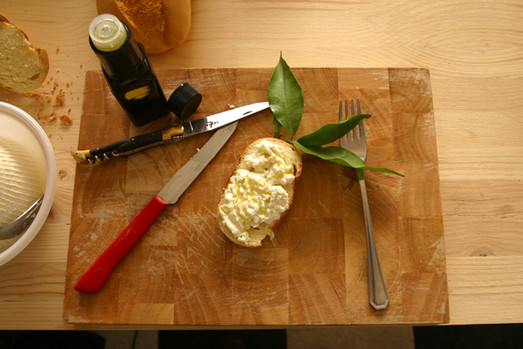
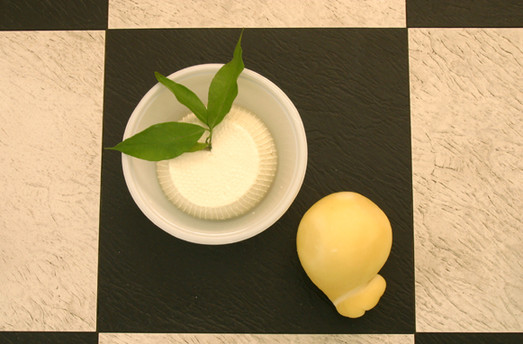
Wednesday, February 14, 2007
Ricotta a la Truck
The concept of “dining a la truck” in Sicily was introduced to me over a loudspeaker. I was still in bed.
Amplified, garbled voices came through the window. I’d only been on the island for about 10 hours and was sure it was local politicians trying to convince the local populace to vote for them. Mercifully, they disappeared and I went back to sleep.
Later, I took a break from work and scanned the rotary from the office window. Below, a woman gave money to a man next to a small white car then walked away, gently cradling a wheel of ricotta.
I ran.
Giuseppe Cappello is a third-generation cheesemaker and seller on wheels.
He opened the back of his tiny white car, then scooped a wheel of ricotta out of a large, white tub containing several other wheels floating in whey.
“When people buy it, the cheese is between half an hour and an hour old,” said Cappello, who sells to an estimated 120 clients and one restaurant from his car. He and his wife Enza also sell to wholesale clients from their farm on the edge of town.
“We’re proud to say that our ricotta is sold hot,” he added, seemingly unaware that he’s got most pizza chains’ claims to fame beat coming and going.
The cheese was still warm.
I paid and ran again, this time toward my kitchen with neighbors shouting quick suggestions on what to do with my prize; one woman ate hers with salad and the quick-e-mart guy said he folded it into his kid’s pasta.
The ricotta had a custard-y texture similar to the white of a soft-boiled egg; a snow-white miracle in a tiny, plastic colander. I cut some bread, added some still-warm ricotta, poured some local olive oil and a sprinkle of salt over it, took a bite and, well, groaned with pleasure.
Tomorrow, I head out in a three-wheeled Vespa truck with the baker…
This is Joe Ray reporting from the Motherland.
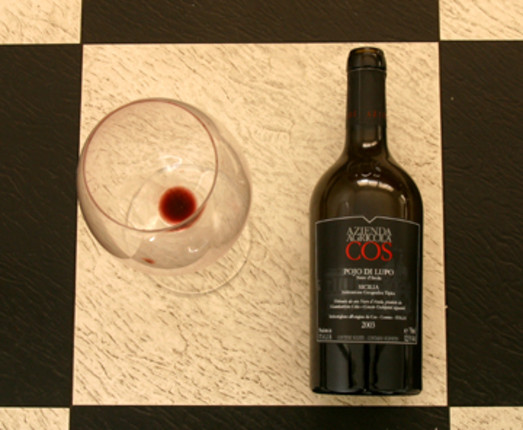
Wednesday, February 07, 2007
Rock & Avola in The Motherland
We have been threatening to seriously taste some wines together since I got here. Tonight, we made good on the promise and I got a sort of Sicilian wine primer as a bonus.
I grabbed the wine from its display space next to its empty cousins on my kitchen floor and stole some big, beautiful tasting glasses from an undisclosed location. To keep the babes of Ispica at bay, we tasted in the office.
I put on some Green Day and Visqueen and we dove in.
The wine was a 2003 “Pojo di Lupo” – made entirely of one of Sicily’s best known grapes, the Nero d’Avola (Black from Avola), from the COS vineyard in the nearby town of Comiso.
We discuss the color – I say “ruby with a brown edge,” and F. says “pomegranate.”
“Is that ‘grenade?’” (like the French), I ask.
“Do you mean in Italian or Sicilan?” he replies.
“Either.”
“No.”
“Nero d’Avola is a grape that’s historically important to Sicily and in the last few years, has become trendy [in other parts of Sicily],” he explained. This latter part raises the hackles of the people in this neck of the woods, as they’d like to see it come from somewhere closer to Avola. Typically, this means towns within a tight radius – Ispica, at about 15 miles from Avola makes the cut, but Comiso, at 30, starts raising eyebrows.
Then again, Avola is the town with an Eiffel Tower replica next to a lit up jet fighter at a bend in the road.
The grape’s newfound popularity is a double-edged sword: Sicily finally gets some well-deserved recognition for making a great wine, but it also means that the number of morons out there making bad wine with good grapes increases.
The nose is where things got interesting.
In a tasting, I can usually tell when I’ve left France, but here things were very different.
“When you go from France to Sicily, it’s like going to Mars,” said F.
This certainly felt like an alien landscape, but a half hour of swirling and smelling before we took a sip began to bear fruit: for me, this wine had a smell of marinated cherries, then something that seemed to me to be mint or menthol that F. pegged as a woody balsamic smell. The last smell was the hardest to peg – somewhere between tea (it reminded me of mom’s Red Rose) and tobacco, the latter turning out to be one of the typical undertones in a Nero d’Avola. Woohoo! For someone like me who gets excited when I can pick one key element out of a wine when I’m really trying, getting three was exciting in a food geek kind of way.
In the mouth it tasted exactly like it smelled – how’s that for well-balanced?
This isn’t always the case, and it turned out to be one of the peculiarities of this producer’s version of the wine, for better and for worse. Nero d’Avola tends to be huge, and the producers reigned it in so much that the tobacco stood out and the big berry tastes that are its hallmarks didn’t even show up until we had the bottle open for a couple of hours.
That said, we finished the bottle; with wine that tends to be huge and full of alcohol (products of the Sicilian sun), you’re either ready to go to bed or chase Sicilian women after a glass or two.
At the end of the night, we switched music to some of F’s favorites - Gerry Mulligan, Steely Dan, and David Bowie doing a curious Beatles cover. Then Frank Sinatra came on and F. grinned, smiled, whistled and tapped his feet.
Which is exactly what should happen when you’re enjoying what you drink.
This is Joe Ray reporting from the motherland.
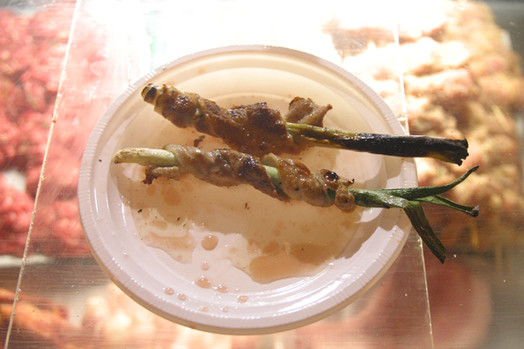
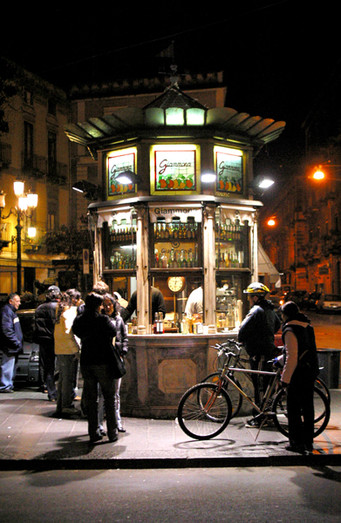
Friday, February 02, 2007
Street Food, Sicilian Style
Walking through the town of Catania, Francesco explained its Festa di Sant’Agata as best he could.
“Agata (like Agatha, with a better sounding name) was the daughter of a noble family, destined to be married to a guy from another family. But she preferred to die because she was devoted to God,” he said, sounding reasonably certain.
“But it’s impossible to starve in this town,” he said.
After working a full day in Ispica yesterday, we hopped in the car and set off on the hour-and-a-half trek to Catania to prepare ourselves for the Feast of Saint Agata.
“Catania is one of the most important places in Italy for street food,” Francesco mentioned a day earlier.
I’m not sure what he was thinking about for the first two days I was here.
We started off with a couple of false trails, which only served to heighten our hunger, before finding a place with a blue neon star with a red letter “A” in the center. Inside, immediately on the left at hip-level, were three vats big enough to fry a horse head or small kid in, with nothing to keep customers from falling in; I’d say “Darwin would love it here,” but my sister would point out that I almost fell into a Frialator once.
A big woman behind the counter introduced us to crispelle, fritter-like things of two different flavors and sizes. We had a ball-shaped one stuffed with ricotta and another, more mangled-stick shaped with anchovies in the middle. I could taste the genius potential, but they were leftovers at the end of the night, and she gave them to us, promising that she’ll set up a full testing plate for us when we go back this weekend. Yeehaw!
Afterward, we wheedled our way through the creepy/beautiful Santo Spirito neighborhood on our way to another street food hotspot. It seemed to be one of those places where you walk in the street because you’re worried you might fall into a hole in the sidewalk.
“I see smoke,” I said.
“That’s our place,” replied Francesco.
Frankly, coming out of Santo Spirito (which Francesco assures me is about to become the town’s next hotspot), the people crowding around the source of the smoke looked like bums around a trash can in the movies. Then we got closer and I could smell how wrong I was.
Via Plebiscito is aptly named, as it’s the where Catania’s street food freaks, err, vote to eat on their feet.
Lining the street, nearly every butcher shop and restaurant has a big, square grill flaming away in front of it and stout men impervious to heat use stubby tongs or their blackened, bare hands flip sausages, large spring onions wrapped in bacon, pork products, breaded quail and, my recent favorite, and the neighborhood specialty, horse steak sandwiches. On the grill, most of the products are regularly brushed with a sort of oregano vinaigrette. The grill tenders, one of whom was carrying an obscene stack of cash in his apron pocket from the night’s haul, flick salt onto the meat in a sort of long-distance sidearm Rollie Fingers style.
Say what you will about eating Trigger, but piled on a big bun and sloshed with the vinaigrette, horse is good stuff. Among other selections, the star of the street was the spring onions wrapped in unsmoked bacon. Sweet, simple, vinegar-y goodness.
Stuffed, we went to Francesco’s favorite places for those tamarind syrup with lemon and sodium bicarbonate drinks to help digest it all – at a little street stand called Giammona. Apparently, Francesco wanted to make sure he trusted me a little more before showing me the best in the city.
He was right and I’m hooked. Fuzzy goodness in a cup.
“It’s a ritual,” said Francesco, “I can’t leave town without stopping there. For me it’s like shutters going down at the end of a meal. After that, I close.”
Technically, we didn’t close – we went and got cannolis at a 24-hour place, and those aren’t technically street food. But they are a story for another day…
This is Joe Ray reporting from the Motherland.
